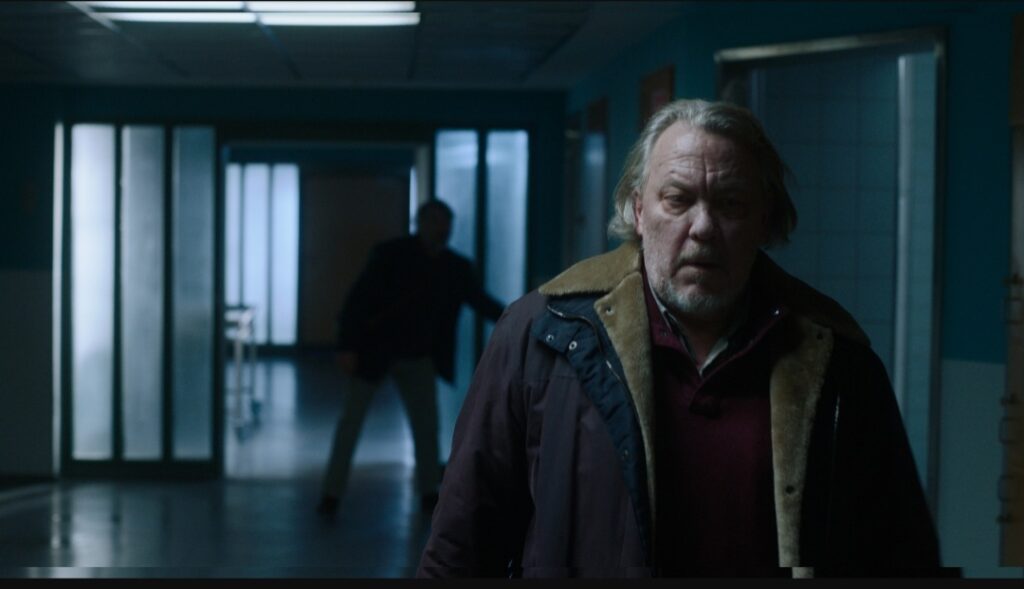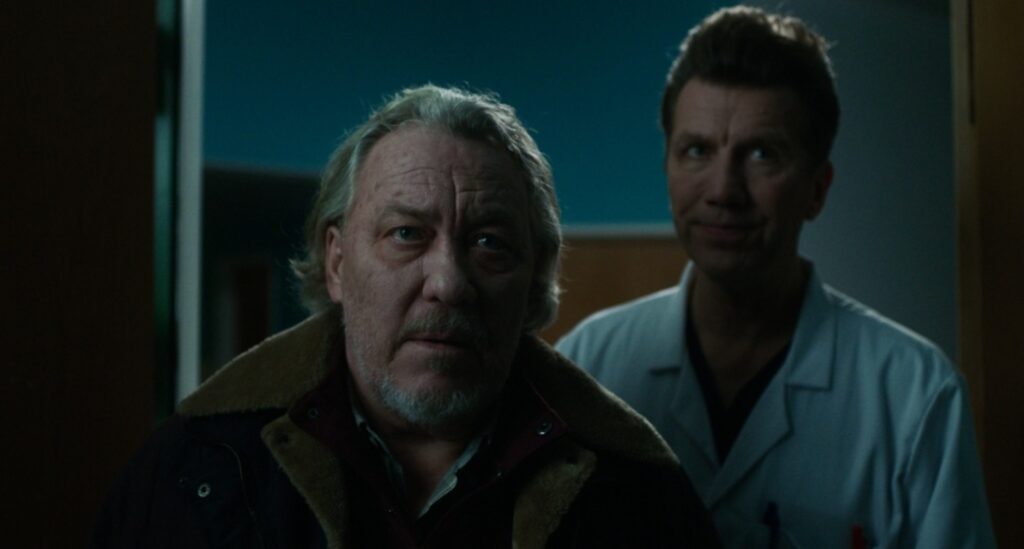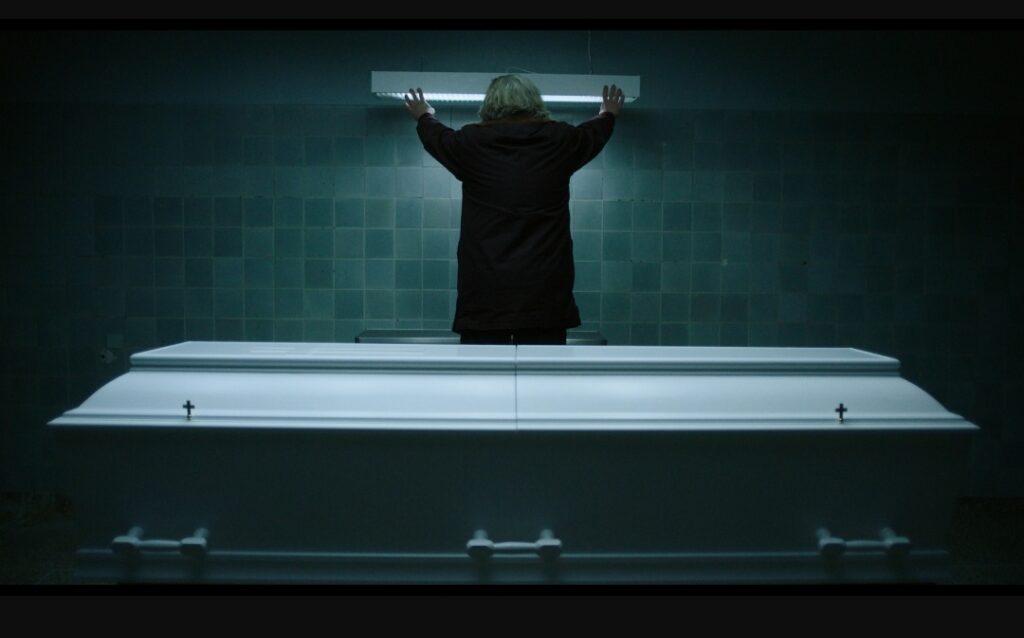Writer and director Lasse Lyskjær Noer finds the absurdity in grief, the humor in loss, and the beauty in moving on in his award-winning short film Knight of Fortune.
In the aftermath of his wife’s passing, Karl Bergstrøm (Leif Andree) finds himself at the mortuary with a seemingly simple task: open his wife’s coffin and say goodbye. But that’s easier said than done, and Karl would rather fix a flickering light bulb than face the loss of his love. He takes refuge in the bathroom, but a man in the next stall over, Torben (Jens Jorn Spottag), isn’t keen on giving him his space. Also a recent widower, Torben convinces Karl to come with him while he says goodbye to his late wife Jette, and their awkward interaction turns sentimental as the men bond over memories of their loved ones.

When the rest of the deceased woman’s family arrives, Karl is so overwhelmed by their emotions that he returns to his wife’s side—but as he stands there with his hands hovering over the lid, he can’t bring himself to lift it. Upon learning from the mortician (Jesper Lohmann) that Torben returns to the mortuary regularly in the hopes of finding closure after the passing of his wife three years ago, Karl seeks out his help. The two men step back inside the morgue to finally face the coffin that Karl couldn’t on his own—this time, together.
Noer’s Knight of Fortune is a simplistic, yet poignant meditation on grief and the numbness of loss, with a darkly humorous underbelly that gives the film a watchable edge. Taking place over the course of a few hours, the film is uniquely structured to condense a wealth of emotions and breadth of feelings into a single afternoon. We are asked to fully experience the revolutions of Karl’s sorrow as he meanders from one room to the next, constantly roving further and further away from the object of his grief.
Yet, even with a myriad of emotions compressed into such a small container, the premise of the film is simple in the best way, never bogged down by character details or over-complicated by dense story. Even after the introduction of the film’s ostensible second protagonist Torben, we care little about the lies he tells or the mystery surrounding his dead wife of three years; it’s the deep emotions that arise as both he and Karl strive for closure that keep us watching. Torben is simply another man in grief searching for a way out, regardless of how fresh or healed his wounds are.
The cinematography (Lasse Ulvedal Tolbøll) plays with space and lighting to underscore the oppressiveness of the mortuary as a reflection of our protagonist’s all-encompassing grief. The setting of the film is lifeless and clinical, tinted with a sickeningly greenish hue, rooms are devoid of anything human save for the people themselves, and walls are plastered with an endless pattern of tiles that shrink the space and leave little room for anything but grief to fester. When Karl attempts to fix a light fixture to distract himself from his wife’s body, the coffin fills the frame behind him from edge to edge like an impassable barrier, and even in the relative quiet and safety of the bathroom, Karl is boxed in, stifled and constricted by plastic walls.

Coupled with a host of close-ups, these shots create a world that feels small and cramped—but they also serve to contrast what few wide shots Tolbøll uses. As Karl’s hands hover over the lid of the coffin near the end of the film, the space suddenly becomes vast and empty, Karl and his wife’s body no more than a sliver in the center of the frame. More than this, it takes until the end of the film for us to breathe the fresh air of the outside world, but even then we’ve grown so accustomed to the uncanny interiors of the mortuary that we are jarred by the unexpected naturalism. These visuals heighten the value of the production as a whole, but more importantly they serve as constant markers of Karl’s inability to make peace with his new normal, to find comfort in the loss of his loved one.
Amid this ever-present sea of loss, though, there is humor that shines through. Each moment is small, never so overtly comedic as to take us out but never so hidden that the tone of the film becomes muddled. As we listen to Torben read from an itemized list of thirty-two apologies to his wife, we sense the duality of grief as a deeply painful, yet completely absurd part of life. The smallest moments of humor remind the audience to breathe, even if Karl himself struggles to, and remind us that how we each cope with loss is unique. The unprompted burst of laughter shared by Torben and Karl on the bench outside epitomizes this, a union of two broken souls through the reality of their loss. It’s both a humorous and tender moment, a breaking of the tension that runs through the film but also a bonding of these men through their shared experience.
Described by the filmmaker himself as “absurd” and “melodic,” Knight of Fortune is by no means a gripping tale of loss; it is a somber contemplation of the many ways in which grief manifests, and the simple struggles that come of it. With a quiet and tender musical theme to accompany the flow of the story (Mathias Gaarde Mikkelsen), we are swept up in one man’s first step towards moving on, and we can’t help but feel that as hard as it may be and as long as it may take to open the coffin’s lid, it’s far lighter with another pair of hands to help.


